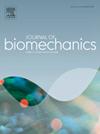The Association Between Foot Morphology and Foot Loading During Gait
IF 2.4
3区 医学
Q3 BIOPHYSICS
引用次数: 0
Abstract
The perceived association between foot type and injury risk has inspired the development of many foot typing methods. The purpose of this study was to determine how well different foot typing methods explained variations in regional foot loading in asymptomatic adults during gait, while considering age, sex, and walking speed as covariates. Six methods were used to determine foot type in 92 asymptomatic adults. An insole pressure sensor system measured peak force and force-time integral during treadmill walking at a self-selected pace. The foot was divided into nine regions and the association between foot type and foot loading was analyzed using generalized estimating equations (GEE) while accounting for the covariates. Over an average of 250 steps per individual, the results demonstrated variability in the association between regional foot loading and foot type. Specifically, Arch Index and X-Ray Arch Type correlated with hindfoot and midfoot loading, while Foot Posture Index correlated with medial midfoot, forefoot, and toe loading. Calcaneal Pitch and Meary’s Angle correlated with medial hindfoot, midfoot, and forefoot loading, while Varus/valgus angle correlated with loading in the forefoot and toes. The location and direction of associations were generally similar for Calcaneal Pitch, Meary’s Angle, and X-Ray Arch Type, and opposite of Arch Index. The analyses demonstrated that walking speed, age, and sex were all important factors that affected the relationship between plantar loading and foot type. Specific foot type methods correlate better with loading in specific foot regions, potentially making them better to evaluate injury risk in those regions.
步态时足部形态与足部负荷之间的关系
人们认为脚型与受伤风险之间存在关联,因此开发了许多脚型分析方法。本研究的目的是确定不同的足型分析方法对无症状成年人步态过程中足部区域负荷变化的解释程度,同时考虑年龄、性别和步行速度等协变因素。我们采用了六种方法来确定 92 名无症状成年人的足型。在跑步机上以自选速度行走时,鞋垫压力传感器系统测量了峰值力和力-时间积分。足部被分为九个区域,在考虑协变量的情况下,使用广义估计方程(GEE)分析了足部类型与足部负荷之间的关系。在每个人平均走 250 步的情况下,结果显示脚部区域负荷与脚部类型之间的关联存在差异。具体来说,足弓指数和 X 射线足弓类型与后足和中足负荷相关,而足部姿势指数与中足内侧、前足和足趾负荷相关。腓骨间距和 Meary 角度与后足内侧、中足和前足的负荷相关,而外翻/外翻角度与前足和脚趾的负荷相关。腓骨距、Meary's Angle 和 X 射线足弓类型的关联位置和方向基本相似,而足弓指数则相反。分析表明,步行速度、年龄和性别都是影响足底负荷与足型之间关系的重要因素。特定足型方法与特定足部区域的负荷相关性更好,可能更适合评估这些区域的受伤风险。
本文章由计算机程序翻译,如有差异,请以英文原文为准。
求助全文
约1分钟内获得全文
求助全文
来源期刊

Journal of biomechanics
生物-工程:生物医学
CiteScore
5.10
自引率
4.20%
发文量
345
审稿时长
1 months
期刊介绍:
The Journal of Biomechanics publishes reports of original and substantial findings using the principles of mechanics to explore biological problems. Analytical, as well as experimental papers may be submitted, and the journal accepts original articles, surveys and perspective articles (usually by Editorial invitation only), book reviews and letters to the Editor. The criteria for acceptance of manuscripts include excellence, novelty, significance, clarity, conciseness and interest to the readership.
Papers published in the journal may cover a wide range of topics in biomechanics, including, but not limited to:
-Fundamental Topics - Biomechanics of the musculoskeletal, cardiovascular, and respiratory systems, mechanics of hard and soft tissues, biofluid mechanics, mechanics of prostheses and implant-tissue interfaces, mechanics of cells.
-Cardiovascular and Respiratory Biomechanics - Mechanics of blood-flow, air-flow, mechanics of the soft tissues, flow-tissue or flow-prosthesis interactions.
-Cell Biomechanics - Biomechanic analyses of cells, membranes and sub-cellular structures; the relationship of the mechanical environment to cell and tissue response.
-Dental Biomechanics - Design and analysis of dental tissues and prostheses, mechanics of chewing.
-Functional Tissue Engineering - The role of biomechanical factors in engineered tissue replacements and regenerative medicine.
-Injury Biomechanics - Mechanics of impact and trauma, dynamics of man-machine interaction.
-Molecular Biomechanics - Mechanical analyses of biomolecules.
-Orthopedic Biomechanics - Mechanics of fracture and fracture fixation, mechanics of implants and implant fixation, mechanics of bones and joints, wear of natural and artificial joints.
-Rehabilitation Biomechanics - Analyses of gait, mechanics of prosthetics and orthotics.
-Sports Biomechanics - Mechanical analyses of sports performance.
 求助内容:
求助内容: 应助结果提醒方式:
应助结果提醒方式:


